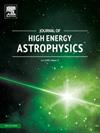Exploring temperature influences on gravitational wave production in binary white dwarfs
IF 10.5
4区 物理与天体物理
Q1 ASTRONOMY & ASTROPHYSICS
引用次数: 0
Abstract
This study investigates the conditions under which gravitational waves (GWs) are emitted during the merger of hot white dwarfs (WDs) in a binary system. Traditionally, these systems consist of two low-mass stars or a more massive WD paired with a less massive companion. In addition, recent work has investigated the possibility that double white dwarf (DWD) mergers are possibly the leading formation channel of massive, rapidly rotating, high-field magnetic WDs, particularly SDSS J221141.80 + 113604.4 (hereafter J2211+1136) and ZTF J190132.9 + 145808.7 (hereafter J1901 + 14588). Motivated by these findings and the Laser Interferometer Space Antenna (LISA) prospects, this study aims to calculate the tidal Love number, the dimensionless tidal deformability, as well as the frequency and amplitude of GWs of hot WDs. The results indicate that the tidal deformability is more pronounced in stars with higher central temperatures and lower masses, which would lead to reduced emission of GWs. In contrast, more massive stars exhibit less deformability, making them prime candidates for generating stronger GWs. Additionally, the analysis of frequency and amplitude reveals that the frequencies of high-mass binaries are smaller and evolve more rapidly, reaching a limit that aligns with the operational detection capabilities of LISA during its initial phase.
探索温度对双白矮星引力波产生的影响
本研究探讨了双星系统中热白矮星(WDs)合并过程中引力波(GWs)发射的条件。传统上,这些系统由两颗低质量恒星或一颗质量较大的恒星与一颗质量较小的伴星组成。此外,最近的工作还研究了双白矮星(DWD)合并可能是大质量、快速旋转、高磁场磁白矮星的主要形成渠道,特别是SDSS J221141.80 + 113604.4(以下简称J2211+1136)和ZTF J190132.9 + 145808.7(以下简称J1901 + 14588)。基于这些发现和激光干涉仪空间天线(LISA)的发展前景,本研究旨在计算热WDs的潮汐Love数、无量纲潮汐变形能力以及GWs的频率和振幅。结果表明,在中心温度较高、质量较低的恒星中,潮汐变形性更为明显,这将导致GWs的发射减少。相比之下,质量更大的恒星表现出更小的可变形性,使它们成为产生更强GWs的首选候选者。此外,对频率和振幅的分析表明,高质量双星的频率更小,演变更快,达到了LISA初始阶段的操作探测能力的极限。
本文章由计算机程序翻译,如有差异,请以英文原文为准。
求助全文
约1分钟内获得全文
求助全文
来源期刊

Journal of High Energy Astrophysics
Earth and Planetary Sciences-Space and Planetary Science
CiteScore
9.70
自引率
5.30%
发文量
38
审稿时长
65 days
期刊介绍:
The journal welcomes manuscripts on theoretical models, simulations, and observations of highly energetic astrophysical objects both in our Galaxy and beyond. Among those, black holes at all scales, neutron stars, pulsars and their nebula, binaries, novae and supernovae, their remnants, active galaxies, and clusters are just a few examples. The journal will consider research across the whole electromagnetic spectrum, as well as research using various messengers, such as gravitational waves or neutrinos. Effects of high-energy phenomena on cosmology and star-formation, results from dedicated surveys expanding the knowledge of extreme environments, and astrophysical implications of dark matter are also welcomed topics.
 求助内容:
求助内容: 应助结果提醒方式:
应助结果提醒方式:


